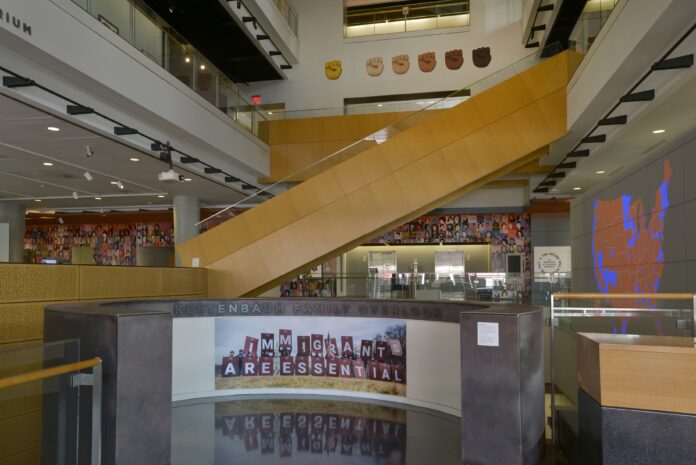
“The Future Will Follow the Past: An Exhibition by Jonathan Horowitz” at the Weitzman National Museum of American Jewish History in Old City will be extended into 2024, a result of its positive reception and popularity. This program is a visual commentary (with multi-perspective audio commentary available) on the current state of the country and how it has transformed since 2020. The exhibition represents narratives of race, Judaism, feminism, LGTBQ+ rights, as well as others, while seamlessly interwoven throughout the museum’s structure.
The Weitzman’s interest in Horowitz per this collaboration was inspired by his own artistry as a means of public engagement.
“He’s an artist who likes to work among people and sees the art not just as something on the wall, but as actual interaction, and so that approach to art and to curating really fit with what we were trying to do here,” said Chief Curator and Director of Exhibitions Josh Perelman.
Per the audio tour, Horowitz mentions his own focus on history, and more specifically, “…looking at different versions of history…and to fill in some gaps.” By putting underrepresented narratives into the forefront, the exhibition uses art to challenge the meta-narrative of America’s past, and in turn shape our present.
Horowitz’s curation features several of his own works that are reflective of his own identity as a gay Jewish man, as well as works from artists of various backgrounds, including Nicholas Galanin, Faith Ringgold, Tabboo!, and Malaquias Montoya, to name a few. The entire museum is utilized as the multimedia and multimedium collection’s gallery. Pieces sharing the narratives of many marginalized communities are ingratiated with the museum’s Jewish historical content.
“We were highly conscious of considering this idea of intersectionality, which, of course, means many different things to many different people,” Perelman said. “In this context, it means that our community stories do not happen in isolation. Although we’re a museum that focuses on the history of Jews, throughout the museum there are stories of many different other people.”
Some stories represented include the colonization of Indigenous peoples in Montoya’s “Cristobal Colón,” America’s history of slavery in Ringgold’s “We Came to America,” the persecution of homosexuals during World War II in Horowitz’s “Pink Curve,” and many others.
As the name suggests, “The Future Will Follow the Past” is an exhibition that is intended to raise questions and create dialogue regarding contemporary issues. Horowitz’s political engagement made him a natural partner for this goal, having the shared ideation of an interactive approach through art. Being a museum of history, The Weitzman provides a setting to explore the past and how it relates to the present.
“There was a very conscious intention to put the works in dialogue with the history being represented in that area of the museum as well as in dialogue with one another,” Perelman said.
In addition to its historical pieces, the collection features modern works, such as Horowitz’s untitled sculpture representing the aftermath of the events at Charlottesville, Tabboo!’s “Tree of Life,” as a dedication to the Tree of Life synagogue shooting in Pittsburgh, and Galanin’s “Never Forget” as a call to action in awareness of stolen Native land.
As a queer artist, Horowitz is also able to bring LGBTQ+ identities into the spotlight, including those that may have otherwise gone unmentioned. One such example is how he gives visibility to his own identity and that of artist Jasper Johns’ — who’s queerness was often unaddressed — through his original work “Rainbow American Flag for Jasper.” The mechanization of these featured works presents art as a means for queer artists to communicate who they are, especially as those narratives often go unrecognized through history. In doing so, it brings visibility, to what may have otherwise been lost, into the present.
The diversity of works and narratives told throughout “The Future Will Follow the Past” has helped it to become an exciting educational setting, especially for schools and students throughout the city. In recognizing and celebrating various marginalized histories alongside that of the American Jewish community, The Weitzman hopes to continue to foster allyship and create a dialogue to address the present issues that we face. As such, the museum looks forward to continuing to feature the exhibition into 2024.
“The Future Will Follow the Past: An Exhibition by Jonathan Horowitz” is extended through 2024 at the Weitzman National Museum of American Jewish History, 101 S Independence Mall E. Tickets are free of charge. You can book a date to visit theweitzman.org.